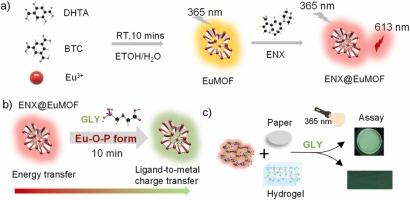基于依诺沙星嵌入eumof的比例荧光传感平台,结合纸质传感器和皮肤贴附水凝胶,用于食品中草甘膦的检测
IF 11.3
1区 环境科学与生态学
Q1 ENGINEERING, ENVIRONMENTAL
引用次数: 0
摘要
为满足食品安全和生态环境保护的迫切要求,需要一种灵敏、用户友好的草甘膦检测方法。在此,我们开发了一种新型的依诺沙星嵌入Eu(III)金属有机框架(ENX@EuMOF)传感平台,用于食品样品中的荧光和视觉双模式GLY检测。ENX@EuMOF在613 nm(减少)和520 nm(增加)波长下对GLY表现出双荧光信号响应,这是由于能量转移效率的改变和配体到金属的电荷转移效应。该比率荧光平台具有良好的灵敏度,荧光和视觉检测的检出限(LOD)分别为0.35 mg/L和10 mg/L。在5mg /L ~ 100mg /L的浓度范围内线性响应良好。此外,它还成功地应用于玉米、葵花籽、大豆、茄子、柑橘和茶叶等受gly污染的食品。同时,开发了基于纸张和聚丙烯酰胺水凝胶的传感器,用于现场快速实时检测GLY。这些微传感器实现了实时、便捷、灵敏的GLY分析,为农业监测提供了高效实用的解决方案,具有广阔的应用前景。本文章由计算机程序翻译,如有差异,请以英文原文为准。

Enoxacin-embedded EuMOF-based ratio fluorescent sensing platform integrated with paper-based sensor and skin-attachable hydrogel for glyphosate detection in foods
To address the urgent requirement for food safety and ecological environmental protection, there is a need for a sensitive and user-friendly method for detecting glyphosate (GLY). Herein, we developed a novel enoxacin-embedded Eu(III) metal-organic frameworks (ENX@EuMOF) sensing platform for fluorescent and visual dual-modes GLY detection in food samples. The ENX@EuMOF exhibited dual fluorescent signal responses to GLY at 613 nm (decrease) and 520 nm (increase) wavelengths, attributed to alterations in energy transfer efficiency and the ligand-to-metal charge transfer effects. The ratiometric fluorescent platform illustrated excellent sensitivity, achieving a low limitation of detection (LOD) of 0.35 mg/L and 10 mg/ L for fluorescent and visual detection, respectively. The linear response fell into the concentration range of 5 mg/L to 100 mg/L. Furthermore, it was also successfully applied to GLY-contaminated food, including corn, sunflower seed, soybean, eggplant, citrus, and tea. Meanwhile, the paper- and polyacrylamide hydrogel-based sensors were developed for rapid and real-time GLY detection on-site. These microsensors facilitated real-time, convenient, and sensitive GLY analysis, offering an efficient and practical solution for agricultural monitoring, which suggests a promising prospect for application.
求助全文
通过发布文献求助,成功后即可免费获取论文全文。
去求助
来源期刊

Journal of Hazardous Materials
工程技术-工程:环境
CiteScore
25.40
自引率
5.90%
发文量
3059
审稿时长
58 days
期刊介绍:
The Journal of Hazardous Materials serves as a global platform for promoting cutting-edge research in the field of Environmental Science and Engineering. Our publication features a wide range of articles, including full-length research papers, review articles, and perspectives, with the aim of enhancing our understanding of the dangers and risks associated with various materials concerning public health and the environment. It is important to note that the term "environmental contaminants" refers specifically to substances that pose hazardous effects through contamination, while excluding those that do not have such impacts on the environment or human health. Moreover, we emphasize the distinction between wastes and hazardous materials in order to provide further clarity on the scope of the journal. We have a keen interest in exploring specific compounds and microbial agents that have adverse effects on the environment.
 求助内容:
求助内容: 应助结果提醒方式:
应助结果提醒方式:


